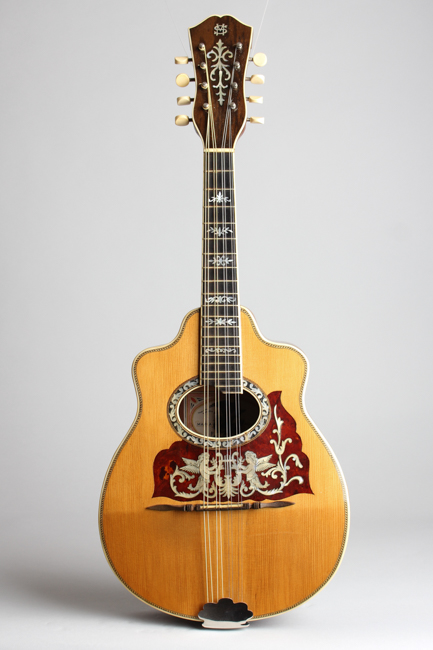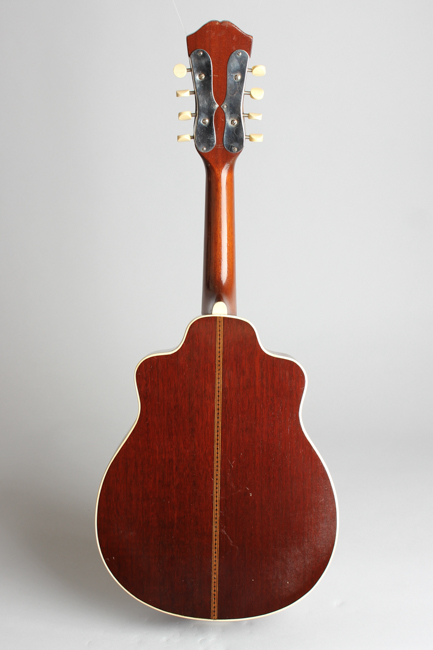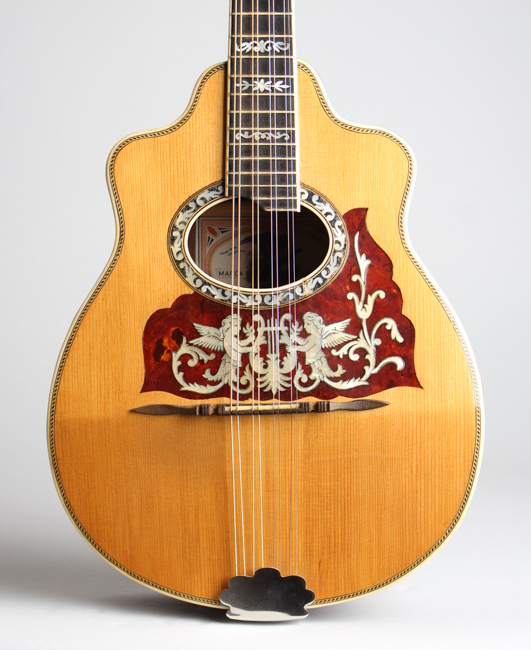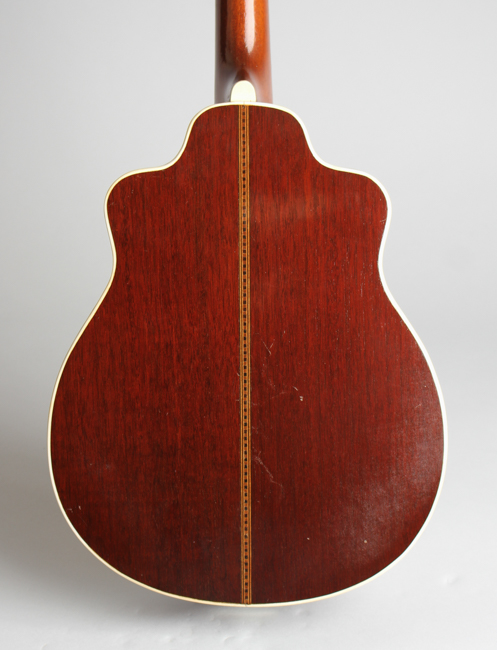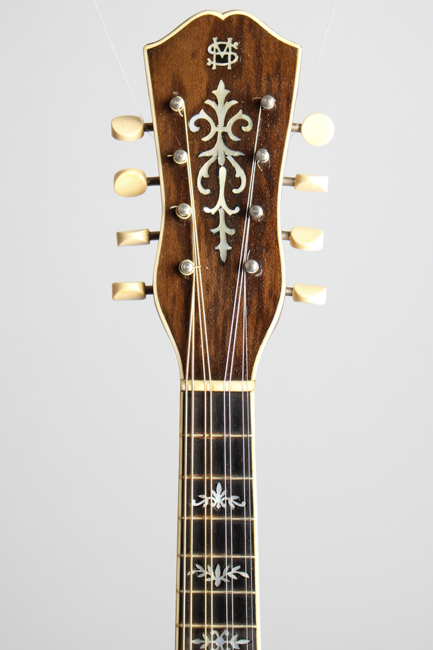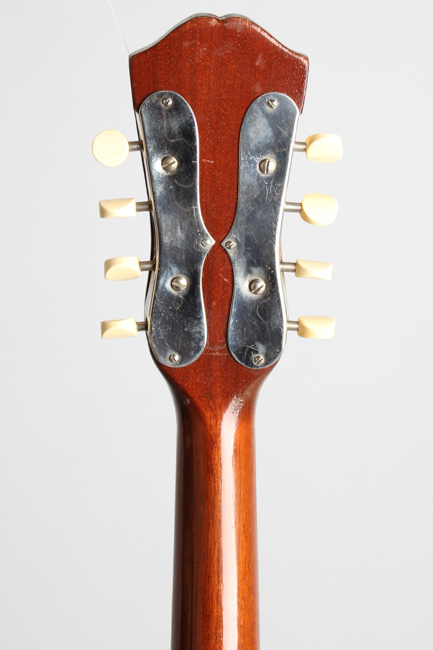Favilla Marca Aquilla Flat Back, Bent Top Mandolin , c. 1925
This item has been sold.
Item # 7424
Prices subject to change without notice.
Favilla Marca Aquilla Model Flat Back, Bent Top Mandolin, c. 1925, made in New York City, natural finish, mahogany back and sides, spruce top; mahogany neck with ebony fingerboard, black hard shell case.
This is a fascinating and beautiful mandolin, not only a fine sounding and playing piece but amazingly well preserved for an instrument from this time and place. New York City of the 1910's and 1920's was teeming with immigrants, including large numbers from Italy. The first quarter of the 20th Century saw the establishment of what has become sometimes referred to recently as "The Italian Guild"- a set of semi-affiliated small retail stores and instrument building workshops operated by Italian immigrant luthier/businessmen including Antonio Cerrito, Raphael Ciani, J. Nettuno, Nicolai Turturro and others. The Favilla Brothers founded one of the most enduring of these firms, which through many twists, turns and family changes lasted into the 1970's. While often similar in design, the instruments produced in the small Little Italy shops exhibit a wide range details and levels of craftsmanship. Bowl back mandolins were predictably the most popular offering, but in the 1920's several makers offered newer mandolin designs that showed a lot of original character.
This Favilla Bros. "Marca Aquilla" mandolin dates to around that time. After the First World War the traditional Neapolitan bowl-back mandolin was falling out of favor in the US, and the Italian luthiers who had made thousands of them in the early 1900's began experimenting with new designs to replace it. Of course it was Gibson's carved-top instruments that were the main competition; these had largely replaced the bowl-back in the popular imagination by 1920. New York luthiers took some time to adapt to the carved-top concept, however. This bent-top, flat back body design with body points near the neck joint was one novel idea, and we have seen examples of similar instruments made in the Ciani shop, whose foreman at the time was John D'Angelico. This Favilla shares trim and inlay patterns with these, and there may well have been some influence going both ways at the time.
On its own merits this is a wonderful instrument, at least as finely made as any similar mandolin we have ever seen. The 1950's and '60's Favilla brand guitars and ukes were solid but basic in design; this 1920's example is both very fancy and exquisitely crafted. The headstock, fingerboard, soundhole edge and inset pickguard all have shaped pearl inlay and the top is bound with half-herringbone marquetry. Everything is bound with ivory Celluloid and the headstock shows the original owner's initials "MS" the mark of a custom instrument. This is a beautiful creation of first-rate materials, with fine spruce top and mahogany back, sides and neck. The label is lovely, with the Favilla Brothers, New York Marca Aquilla brand and a rampant eagle logo. One of only a couple of these we have ever seen, and as nice as we can imagine.
Overall length is 24 1/4 in. (61.6 cm.), 9 7/8 in. (25.1 cm.) wide at lower bout, and 2 5/8 in. (6.7 cm.) in depth at side, taken at the end block. Scale length is 13 1/2 in. (343 mm.). Width of nut is 1 3/16 in. (30 mm.). Amazingly clean overall with very little play wear, especially for its age. There is one small repair to the soundhole edge and some slight marring to the back finish from contact with a case lining. Plays and sounds excellent with a remarkable deep and sweet tone for a mandolin. Comes in a period Banjo-Mandolin case that is an inexact fit. Excellent + Condition.
This is a fascinating and beautiful mandolin, not only a fine sounding and playing piece but amazingly well preserved for an instrument from this time and place. New York City of the 1910's and 1920's was teeming with immigrants, including large numbers from Italy. The first quarter of the 20th Century saw the establishment of what has become sometimes referred to recently as "The Italian Guild"- a set of semi-affiliated small retail stores and instrument building workshops operated by Italian immigrant luthier/businessmen including Antonio Cerrito, Raphael Ciani, J. Nettuno, Nicolai Turturro and others. The Favilla Brothers founded one of the most enduring of these firms, which through many twists, turns and family changes lasted into the 1970's. While often similar in design, the instruments produced in the small Little Italy shops exhibit a wide range details and levels of craftsmanship. Bowl back mandolins were predictably the most popular offering, but in the 1920's several makers offered newer mandolin designs that showed a lot of original character.
This Favilla Bros. "Marca Aquilla" mandolin dates to around that time. After the First World War the traditional Neapolitan bowl-back mandolin was falling out of favor in the US, and the Italian luthiers who had made thousands of them in the early 1900's began experimenting with new designs to replace it. Of course it was Gibson's carved-top instruments that were the main competition; these had largely replaced the bowl-back in the popular imagination by 1920. New York luthiers took some time to adapt to the carved-top concept, however. This bent-top, flat back body design with body points near the neck joint was one novel idea, and we have seen examples of similar instruments made in the Ciani shop, whose foreman at the time was John D'Angelico. This Favilla shares trim and inlay patterns with these, and there may well have been some influence going both ways at the time.
On its own merits this is a wonderful instrument, at least as finely made as any similar mandolin we have ever seen. The 1950's and '60's Favilla brand guitars and ukes were solid but basic in design; this 1920's example is both very fancy and exquisitely crafted. The headstock, fingerboard, soundhole edge and inset pickguard all have shaped pearl inlay and the top is bound with half-herringbone marquetry. Everything is bound with ivory Celluloid and the headstock shows the original owner's initials "MS" the mark of a custom instrument. This is a beautiful creation of first-rate materials, with fine spruce top and mahogany back, sides and neck. The label is lovely, with the Favilla Brothers, New York Marca Aquilla brand and a rampant eagle logo. One of only a couple of these we have ever seen, and as nice as we can imagine.
Overall length is 24 1/4 in. (61.6 cm.), 9 7/8 in. (25.1 cm.) wide at lower bout, and 2 5/8 in. (6.7 cm.) in depth at side, taken at the end block. Scale length is 13 1/2 in. (343 mm.). Width of nut is 1 3/16 in. (30 mm.). Amazingly clean overall with very little play wear, especially for its age. There is one small repair to the soundhole edge and some slight marring to the back finish from contact with a case lining. Plays and sounds excellent with a remarkable deep and sweet tone for a mandolin. Comes in a period Banjo-Mandolin case that is an inexact fit. Excellent + Condition.
